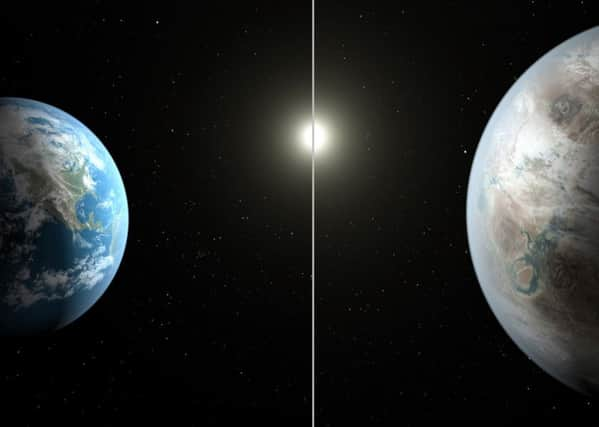Earth-like planet, Kepler-452b, found by Nasa


The Kepler 452b, or Earth Two is 1,400 light years away and is being deemed as a “bigger, older cousin” to Earth. It is the smallest planet found so far that lives within a “habitable” zone around a star similar to our own sun.
The planet is 60 per cent larger in diameter than Earth with an orbit is 385 days – compared to our own 365 days. Scientists believe that is more than enough time for life to have been established “somewhere on its surface, or in its oceans”.
Advertisement
Hide AdAdvertisement
Hide AdNo one knows if life has evolved on the planet. But since the parent star is 1.5 billion years older than the sun, scientists claim any creatures living there could be far more advanced than they are on Earth.
That makes Kepler-452b a good candidate for scientists involved in the Search for Extra Terrestrial Intelligence (Seti).
News of Kepler-452b’s discovery was released by astronomers operating Nasa’s Kepler space telescope.
Dr Jon Kenkins, from Nasa’s Ames Research Centre in Moffett Field, California, said: “We can think of Kepler-452b as an older, bigger cousin to Earth, providing an opportunity to understand and reflect upon Earth’s evolving environment.
“It’s awe-inspiring to consider that this planet has spent six billion years in the habitable zone of its star - longer than Earth.
“That’s substantial opportunity for life to arise, should all the necessary ingredients and conditions for life exist on this planet.”
The star system is located 1,400 light years away in the constellation of Cygnus, the Swan. Evidence suggests the new planet is rocky, like the Earth.
Ground-based observations from three US observatories confirmed that Kepler-452b was indeed a planet and helped to pin down its size and orbit.
Advertisement
Hide AdAdvertisement
Hide AdAnalysis of data from 2009 to 2013 has increased the number of potential planets identified by the space telescope to 4,696.
Twelve of the new planet candidates have diameters between one and two times that of the Earth and orbit in their star’s habitable zones.
The habitable, or “Goldilocks” zone, is defined as an orbital path that is not too hot or cold, but just the right distance from a star to permit liquid surface water.
John Grunsfeld, associate administrator of Nasa’s Science Mission Directorate in Washington DC, said: “On the 20th anniversary year of the discovery that proved other suns host planets, the Kepler exoplanet explorer has discovered a planet and star which most closely resemble the Earth and our Sun.
“This exciting result brings us one step closer to finding an Earth Two.”
Earlier this week, physicist Professor Stephen Hawking helped launch a new £64 million project to hunt for radio signals from alien civilisations.
Speaking at the Breakthrough Listen launch event held at the headquarters of the Royal Society in London, Prof Hawking said: “We believe that life arose spontaneously on Earth so in an infinite universe there must be other occurrences of life.
“Somewhere in the cosmos, perhaps, intelligent life may be watching these lights of ours aware of what they mean. It is time to commit to finding the answer.”